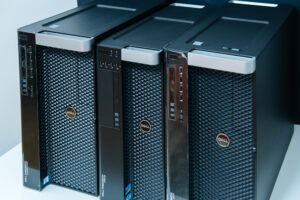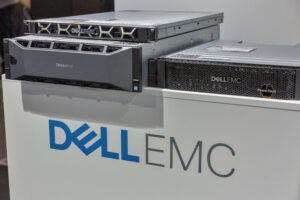Dell Inc. stands as a global leader in the PC market and a significant player in enterprise server manufacturing. With a history rooted in innovation and customer-centric solutions, Dell’s PowerEdge server line is essential for modern data centers. Understanding how to efficiently manage these servers directly impacts data center revenue, making solutions like ServerLIFT crucial for optimizing operations.
The Dell Legacy: From Dorm Room to Data Center Dominance
 Row of three new Dell Precision T3610 T 7910 Xeon workstation for heavy computing AI calculations – low angle
Row of three new Dell Precision T3610 T 7910 Xeon workstation for heavy computing AI calculations – low angle
The Dell story began in a University of Texas dorm room in 1984, founded by Michael Dell as PC’s Limited. His vision was to sell custom-built PCs directly to customers, bypassing the traditional retail model. This direct approach proved incredibly successful. Within its first month, PC’s Limited generated $180,000 in sales, demonstrating the immediate demand for personalized computing solutions. This early success laid the foundation for what would become a tech giant.
Rebranded as Dell Computer Corporation in 1987, the company went public in 1988, further fueling its rapid expansion. The late 1980s saw the launch of Dell’s first notebook computer and sales exceeding $2 billion. Despite facing challenges in the early 1990s, Dell rebounded, entering the Fortune 500 and pioneering online computer sales in 1996. By 1999, Dell had risen to become the world’s largest PC manufacturer, driven by its commitment to customization, efficient shipping, and user-friendly online experience.
The 2000s marked Dell’s diversification beyond PCs, rebranding as “Dell Inc.” to reflect its broader portfolio. Facing increased competition and shifting market dynamics, Michael Dell returned as CEO, implementing strategies to streamline operations and reduce costs. This led to a significant shift, culminating in Dell going private in 2013 through a major leveraged buyout, a move that reportedly doubled the company’s value within two years.
Dell Technologies: A Modern Tech Powerhouse
A pivotal moment arrived in 2016 with the merger of Dell and EMC Corporation. This $60 billion acquisition, the largest tech deal in history, created Dell Technologies. The reorganization established Dell Technologies as the parent company, encompassing three key divisions: Dell Client Solutions Group, Dell EMC, and VMware. This strategic move positioned Dell as a comprehensive technology provider, spanning client computing, data storage, and virtualization.
 Dell EMC logo with Dell products featured
Dell EMC logo with Dell products featured
The COVID-19 pandemic in 2020 further underscored Dell’s importance in the technology landscape. With the surge in remote work, commercial PC sales, particularly notebooks, experienced significant growth, boosting Dell’s financial performance. Beyond PCs, Dell offers a wide array of products, including servers like the PowerEdge rack-mounted series, critical for modern data center infrastructure.
Dell PowerEdge Servers and the Importance of Efficient Deployment for Revenue
Dell PowerEdge Rack Servers are designed to meet diverse computing needs, ranging from basic web hosting to demanding workloads like high-performance computing (HPC), virtualization, and artificial intelligence (AI). These servers, utilizing Intel and AMD Opteron processors, are available in configurations from 1-socket to 4-socket systems, providing scalable solutions for businesses of all sizes.
The efficient deployment and maintenance of Dell PowerEdge servers are directly linked to data center operational efficiency and, consequently, Server Lift Revenue. Downtime during server installation or maintenance can lead to significant revenue loss. Solutions that streamline these processes and minimize risks are essential for maximizing data center profitability.
This is where ServerLIFT solutions become invaluable. ServerLIFT is specifically designed to safely and efficiently handle Dell rack-mounted equipment, including a wide range of PowerEdge servers. By utilizing ServerLIFT, data centers can:
- Reduce Downtime: ServerLIFT equipment ensures faster and safer server installation and removal, minimizing downtime and maximizing server uptime, which directly contributes to sustained revenue streams.
- Improve Operational Efficiency: The precision and ease of use of ServerLIFT systems optimize data center operations, allowing IT staff to handle server deployments and maintenance more quickly and efficiently.
- Enhance Safety and Reduce Damage: ServerLIFT minimizes the risk of server damage and workplace injuries during handling. Protecting valuable server equipment and ensuring staff safety are crucial for long-term cost savings and operational continuity, indirectly boosting revenue by preventing losses.
In conclusion, Dell’s PowerEdge servers are a cornerstone of modern data center infrastructure. To fully leverage their potential and maximize server lift revenue, efficient and safe handling solutions are paramount. ServerLIFT provides the specialized tools needed to optimize Dell server deployment and maintenance, contributing to enhanced data center operations and a stronger bottom line. For detailed information on ServerLIFT compatibility with specific Dell PowerEdge models, consult the server database.
